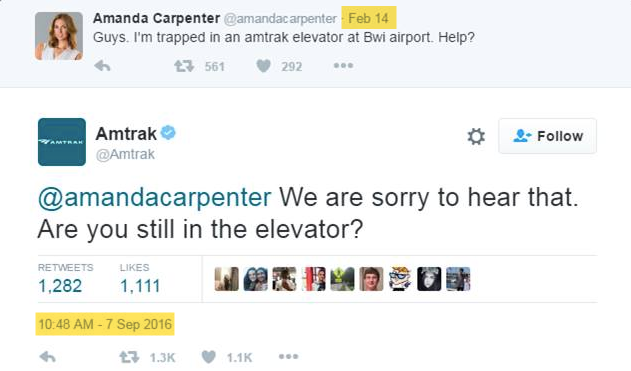 The opportunities to fail at social media are plentiful. It’s easy to see why, now that people turn to social media more often to engage with brands.
The opportunities to fail at social media are plentiful. It’s easy to see why, now that people turn to social media more often to engage with brands.
Social has matured as a communication channel and people have blended it into their lives. They expect brands to do the same, and in the race to do that, brands focus on the outcomes without determining their plan, process, or policies.
Hey, I get it. Some days there just isn’t enough time or enough “operational will” to make it happen. Something has to give and social media strategy seems like a lot of work.
The truth is, the investment in social media strategy pays valuable dividends and reduces the chance of a company-wide fail at social media.
Publishing high-quality, original content that leaves the consumer saying, “This was written specifically for me,” doesn’t happen in a vacuum.
The web is driven by content and if the company isn’t reaching its customers in this way, there’s a good chance they’re not reaching them at all.
I was in talks recently with an agency prospect who has been in the print advertising business for 25+ years. They recognize their need to shift focus to digital and are struggling to retain profit and remain relevant.
Get my latest business tips, exclusive content, and a bit of fun straight to your inbox with the Kruse Control Newsletter. Boost your profits with our proven advice. Sign up now – it’s free!
Shifting focus is only the first step.
To increase revenues (by either offering digital/social media solutions or using social media to promote the company), requires true business transformation. I applaud any company who takes on digital transformation because, while the alternative is a slow agonizing death, it’s a very difficult process with many pitfalls.
Social media failure comes in many forms.
In times of crisis, we lack good judgment. When you’re struggling, it’s often the first inclination to jump into social media solutions without any plan whatsoever. The temptation is great because there’s a lot of opportunity knocking, however, so many are missing the mark!
If you don’t build a strong foundation, you’ll have trouble creating anything of value.
The following 12 new ways to fail at social media were gleaned from Kruse Control’s real-life experiences in the 12 months.
The solutions provided represent how we approach business. I began with the most difficult hurdles to get over, however, each one should be considered if you’re planning to use social media to improve your digital reputation.
1. No Executive Buy-in
This one is first because without it, you’re only going to go so far before the boss questions why you’re doing it and expects results. Every marketer and their boss should expect results but without buy-in there’s a success ceiling.
A lot of bosses think social media is a “fringe marketing idea” and prefer to stick with “what they know works,” (status quo).
The problem there is that “what works” very likely doesn’t work anymore…or at least not very close to how it once did. If you’re the boss, admitting this is your first step to freedom.
If you’re not the boss, and need to convince the executive suite that social media is worthwhile, supply them with indisputable data on a regular basis to support your case…and don’t give up.
2. No Written Social Media Strategy
I spoke to a group a few weeks ago and when I asked how many had a written social media strategy, sadly no one raised their hand.
Without social media strategy, content is just stuff…and the world has enough stuff.
If you enjoy taking longer to reach – or completely miss – your goals and wasting good money on tactics that don’t work, by all means, go without social media strategy.
Companies that want to engage more customers need a specific strategy that clarifies their message.
3. Absence of a Defined Process
I’ve witnessed many companies using social media without a clear idea of what social business success actually looks like.
As time goes on, your “social community” will grow, your team may grow, and you’ll need specific processes to manage your social media. Here again, a developed, defined process is your best friend; it will eliminate 90% of fails at social media.
- Your content library will grow so you’ll need solutions for maintaining and repurposing it.
- More contributors will come to the party. You’ll want everything set up so that they can do their part without a lot of friction.
- Use of the content calendar will prove its value even more.
- You’ll need to step up your tracking game because investments in human resources, expenses, and time will increase.
Collaboration and project management tools help manage processes and workflows:
- Slack, Trello and Basecamp are great for project management and team communication.
- For team content production and employee brand advocacy there are many players in this space. I have peripheral knowledge of Gaggle Amp, Post Beyond, Kapost, and Dynamic Signal. These tools require larger financial investments so check out this list with user reviews.
Pro Tip: The company’s content is an asset. It’s a valuable knowledge base so treat it as such.
4. Disregarding the Value of a Savvy Social Media Manager
It might be obvious to many but judging by the number of social media fails that happen, it bears repeating that having a savvy social media manager speaking for your company is key to protecting your digital reputation.
The duties of a social media manager encompass marketing, PR, sales, customer service and community management. Interacting with your customers online or offline, requires a set of skills that are uncommon today.
Many failures happen because company decision-makers choose an intern or “someone young” to represent the company on social media. Here’s a favorite fail of mine (notice the highlighted dates):

5. Ignoring Your Customers’ Questions
Customers have questions about what you sell and why you sell it. What are you doing to answer their questions?
Ignoring customer questions can happen many different ways.
- No helpful, useful blog content.
- No social media posts showing why you’re the best choice.
- No one responding to comments on Facebook, Instagram, or Twitter.
- No response to online reviews.
6. Lack of Social Media Engagement with Website Content
One of the biggest fails at social media is not using it to engage more customers with your website in meaningful ways.
Your website serves as the company’s digital storefront. A typical site has a home page, services, pricing, and contact us pages but in today’s climate, that’s the bare minimum. Static content (pages that don’t typically get updated) works fine for those who already know you.
But to attract and engage more customers today, it takes helpful, high-quality, original information via social media.
The company blog should provide consistent, high-quality information for all stages of the buyer’s journey. The added benefit of a blog is it improves “organic” search visibility and authority. Real-life stories about your brand, answers to frequently asked questions and unique customer testimonials help round out your content mix.
7. Not Leveraging Content Creators
According to Edelman’s Trust Barometer, employees are the single most trusted representative of the company (outpacing the CEO, CFO and management). “Brand experts” (aka: employees) possess the knowledge that customers need and their seasoned expertise fosters more trust than any ad you’ll ever run.
Companies who wish to improve their digital reputation weave social media into employees’ daily duties. There’s huge “goodwill” value in employee-generated content and those businesses who are able to leverage it win customers.
8. Not Using a Content Calendar
Now that we’ve established that planning is key to avoiding social media fails, we need to talk about how to save time and improve results.
A content calendar, especially if you have a group of content creators, is the best, most efficient way to cover all your bases. A monthly content calendar provides:
- Touchpoint for brainstorming ideas.
- Helps clarify your message.
- Content is centrally-managed, leaving no guesswork.
- Visual plan of your publishing.
- Identifies upcoming holidays and other important events.
- Supports the ideal strategy for marketing campaigns, especially those tied to timelines.
9. Not Using Social Advertising to Engage More Customers
Social media is now pay to play. Social ads, in particular Facebook ads, work very well at getting more eyeballs on your content.
Once content is planned, created and published, the next step is to ensure people see it and engage with it. Expecting your social media posts to reach target customers without using social ads is the equivalent of shouting into an echo chamber.
10. Lack of Design Aesthetic
Fonts, colors, images, placement, and brand aesthetic matter a lot on social media.
Social is visual medium. Everything you publish requires an understanding of the brand and an artistic eye to make them pop. If you weren’t blessed with this talent, and can admit it(!), get support and guidance. ROI is important so don’t scrimp on the essentials.
There are great tools like Canva to design visual social media content but let’s face it, if you can’t tell the difference between good and poor quality visual content, these tools will not help you.
11. Failing to Measure and Analyze Your Results
I feel like all I do is talk about choosing data over opinion, but it’s important and from what I see, many are ignoring their data.
A company must know where it’s been, and where it is today, to know where it needs to go.
Avoiding fails in social media equates to Goals>Strategy>Execution>Measure>Analyze…and repeat. Social is a right now medium. There is no way to know for sure if you’ve succeeded unless that happens.
12. No Social Media Policy
Never venture into the shark-infested waters of social media without a comprehensive social media policy. This goes for every single social profile, whether it’s a company or an individual.
If you’re a company…
Educate employees on what social media is and why it’s important. Provide guidelines on how employees should conduct themselves, how to determine what’s appropriate, and what’s off limits. You also need a strategy for crisis management. The effort you put into laying the foundation for employee social media use will pay off when (not if) sticky situations arise.
If you’re an individual…
Educate yourself on what social media is for you and why it’s important…for you. While you don’t need to necessarily write it down (although it would be a good idea), determine your policy for content publication, when you’ll contribute to conversations, how you’ll respond and what subjects you’ll steer away from, no matter how tempting they may be.
In Conclusion…
Please don’t let this happen to you. Protect yourself, your brand, your revenue and your digital reputation with a successful social media strategy that guards against all of these potential social media fails.
